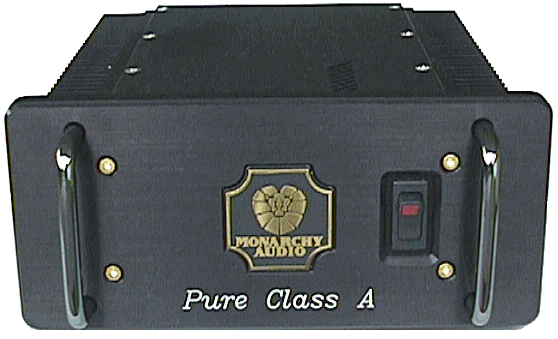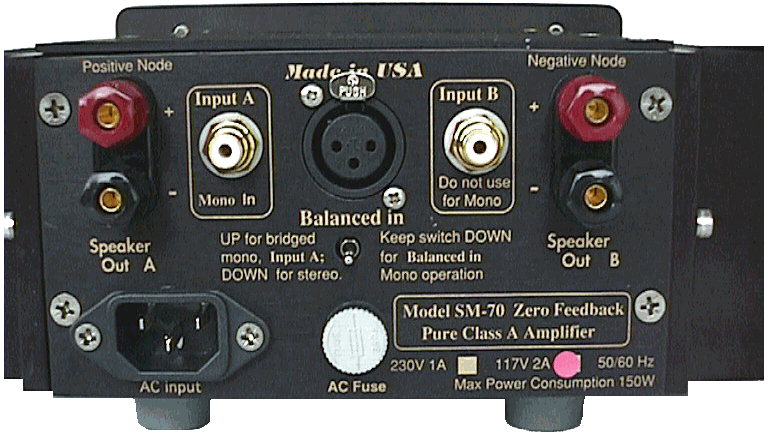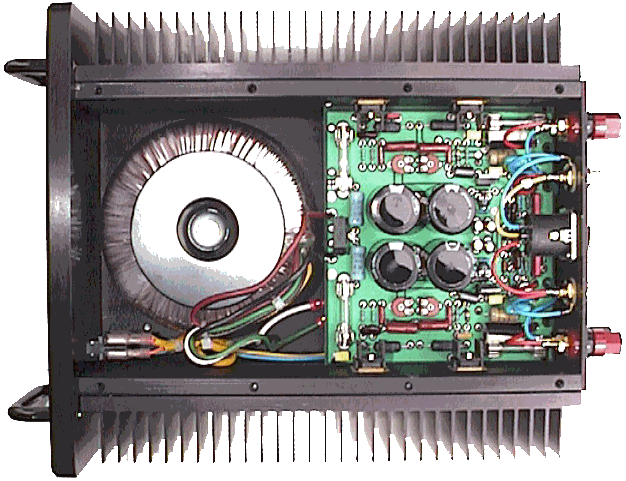Monarchy Audio SM-70 Pro Zero-Feedback Amplifier
| Monarchy Audio SM-70 Pro Zero-Feedback Amplifier |
| Frank Alles |
| 2 May 2000 |
 Specifications
Specifications
Frequency Response:
20Hz to 30KHz +/- 0.5 dB
THD: under 0.05%
S/N Ratio: better than 90 dB stereo mode, better than 100 dB Balanced mono mode
Power Output:
Stereo Mode: 8 Ohm Load: 25 Watts rms × 2, 4 Ohm Load: 40 Watts rms × 2
Mono Mode: 8 Ohm Load: 80 Watts rms, 4 Ohm Load: 120 Watts rms
Minimum Load Impedence tolerated: 3 Ohms continuous, 2 Ohms intermittent
Input Impedence: 100k-Ohm
Input Sensitivity: 1 Volt rms for full output
Dimensions: 5″ × 11″ × 13″ (H × W × D)
Weight: 24 lb.
Price: $980. USD each
Monarchy Audio
380 Swift Ave., #21
S. San Francisco, CA 94080
Phone: 650-873-3055
Fax: 650-588-0335
E-mail: monarchy@earthlink.net
Website: www.monarchyaudio.com
“Maintaining harmonic integrity is essential to preserving the tonal qualities of the instruments and allows them to be reproduced in a manner that more closely resembles their respective natural sonic signatures. In this one area the SM-70 Pro can compete with the very best amplifiers available, tube or solid-state.”
In the latter half of 1998, when Monarchy Audio’s “Jefe Grande,” a.k.a. C.C. Poon introduced the original SM-70 (stereo/mono) amplifier, I was fortunate enough to be among the first reviewers to receive a pair for evaluation. To my surprise it turned out to be one of the best sounding amplifiers I had heard in my system irrespective of its price and limited output power.
 It sounded marvelous on my Paradigm Reference Studio/100 speakers, displaying impressive tonal accuracy along with excellent control of the twin 8″bass drivers in the lower octaves. Using it to power the electrostatic panels of my InnerSound Eros electrostatic speakers also proved to be an eye-opener, resulting in its residence in my primary reference system for an extended period of time. For whatever reason, strings, brasses and vocals sounded more convincing when reproduced through these diminutive Zero-Feedback, Class-A amplifiers. Best of all, the high frequency reproduction was natural, non-fatiguing and satisfying, which was no small accomplishment. Because of the difficult capacitive/resistive load that the Eros presents to an amplifier, many other amplifiers that I had previously held in high regard failed to perform well in the treble spectrum. The only real downside to using the SM-70 to drive the Eros was that at high dB volume levels the sound would sometimes harden a bit when the amps were forced to work beyond their clipping threshold.
It sounded marvelous on my Paradigm Reference Studio/100 speakers, displaying impressive tonal accuracy along with excellent control of the twin 8″bass drivers in the lower octaves. Using it to power the electrostatic panels of my InnerSound Eros electrostatic speakers also proved to be an eye-opener, resulting in its residence in my primary reference system for an extended period of time. For whatever reason, strings, brasses and vocals sounded more convincing when reproduced through these diminutive Zero-Feedback, Class-A amplifiers. Best of all, the high frequency reproduction was natural, non-fatiguing and satisfying, which was no small accomplishment. Because of the difficult capacitive/resistive load that the Eros presents to an amplifier, many other amplifiers that I had previously held in high regard failed to perform well in the treble spectrum. The only real downside to using the SM-70 to drive the Eros was that at high dB volume levels the sound would sometimes harden a bit when the amps were forced to work beyond their clipping threshold.
 The new SM-70 Pro amplifier is essentially a heavy-duty version of the SM-70. The basic circuit design is the same – to offer an analogy, it’s like visiting McDonald’s and ordering your favorite “Extra Value Meal” Super Sized! There is simply more of all the good stuff.
The new SM-70 Pro amplifier is essentially a heavy-duty version of the SM-70. The basic circuit design is the same – to offer an analogy, it’s like visiting McDonald’s and ordering your favorite “Extra Value Meal” Super Sized! There is simply more of all the good stuff.
I contacted C.C. Poon and asked him to supply a list of the various upgrades and changes for the new model and the following was his response:
“Hi Frank, Briefly, the SM-70 Pro will have the following:
1. Double input drivers
2. Double output MOSFETS
3. Higher-power toroidal transformer
4. Larger heatsinks and chassis
5. Higher power output: 120 Watts rms @ 4 Ohms, 80 Watts @ 8 Ohms (mono-block
operation)
6. Higher value filter-capacitors — now 60,000 uF (MFD) total!
7. Double rectifiers
8. Larger front panel
9. Heavier: 24 lb.
10. Higher price: Retail $980.The original SM-70 will continue to be available at $719, and is ideal for home-theatre use.”
I would add to this that a single SM-70 Pro can be used as a stereo amp with an output power of 40 Wpc rms into 4 Ohms. So the price for the Pro-version is a bit higher, especially for a pair, but I think you can see that you are getting quite a few extra “fries” in the bargain. Although one could justifiably equate Monarchy with McDonald’s in terms of its pricing (by High-End standards); I have found the sonic palette of its various products to better approximate the fine dining experience.
The amplifier is a Class-A design that eschews the use of ANY global feedback, although some local feedback is employed. Surprisingly, distortion (THD) is held to below 0.05% at rated output. Monarchy claims that due to the “Zero-Feedback” design, dynamics are unbridled and the amp exhibits very clean clipping when overdriven. This translates to an amplifier that subjectively sounds more powerful than its specs would imply.
The switch from stereo to mono configuration is accomplished by flipping a rear panel switch in concert with a swapping of the speaker output taps. The monoblock configuration uses only the Left channel input in conjunction with the two “hot” (red) speaker terminals and the polarity is indicated above the posts. There is a lighted front panel toggle switch and a female IEC connector on the rear for use with detachable AC power cords. The unit is thoroughly fused and protected.
Additionally each amp has a balanced XLR input for use as a true balanced monoblock. Mr. Poon prefers the balanced input configuration, but for my tests I used only the RCA inputs.
Set-Up
Most of my listening impressions were gathered from a system using the somewhat difficult to drive Carver AL-III full-range ribbon-hybrid speakers. These proved to be a formidable load for the SM-70 Pro amps (as monoblocks) which ran quite warm (toasty) to the touch when driving the speakers at moderate volume levels. My Sonogy Black Knight amp and my InnerSound ESL amp** felt moderately warm while powering the AL-IIIs at even higher volume levels. The InnerSound amp normally runs stone cold when powering my Eros electrostatic speakers, even at extremely loud levels. Admittedly, both the InnerSound and Sonogy amps do not operate entirely in class-A; and both amps are rated to deliver much higher power than the SM-70 Pro. My best advice is to provide plenty of open space for ventilation around the amplifiers during use.
[**Editor’s Note: the InnerSound amp is manufactured by Coda for InnerSound. Its design parameters were optimized to drive electrostatic speakers and a full review will follow soon, right here at StereoTimes.com. Stay tuned!]
My signal source was a Parasound C/BD-2000 transport coupled to the Parasound D/AC-2000 Ultra Processor via a silver coaxial digital cable by Harmonic Technology. This combo fed an AHT tube line stage using a pair of 5692 tubes. The interconnects were WireWorld Eclipse IIIs and the speaker wire was a 10 ft. run of AudioQuest Type IV HypeLitz.
In addition to driving the AL-IIIs the SM-70 Pros spent some time driving the ESL panels of the InnerSound Eros. With the more sensitive Eros as the load, the amps did not get as hot as they had with the Carvers even at very loud levels. Neither did the sound harden as it did with the original SM-70. I can recall playing several cuts from Cake’s Prolonging the Magic CD (Capricorn 314 538 092-2) and seeing the needle on my dB level meter hover around 94 dB, reaching nearly 100dB on peaks at my listening seat! This is really LOUDER than I normally would listen, but the presentation sounded so relaxed and clean that I just let it crank away. Even at that level, the amps ran cooler than they did when driving the Carvers at an average level of about 86 dB (8dB less).
During my evaluation, there were no operational glitches or significant anomalies to report. There was no noticeable mechanical hum from the amps, but there was a mild electrical hum from the speakers that could only be detected in close proximity to the drivers – not a big deal in my view. With an amp of such compact dimensions with the power transformer in such close proximity to the active circuitry, this is not at all surprising or unexpected.
One idiosyncrasy to note is that the input sensitivity is very high requiring only 1-Volt input, peak to peak, for full rated output. Combined with a high 100k-Ohm input impedance, this allows the SM-70 Pro to be driven easily by passive preamplifiers. The flip side to this coin is that the combination of a high-noise active preamplifier used in conjunction the SM-70 Pro to feed high-efficiency loudspeakers could result in a very audible level of static hiss from the system. I discovered this first-hand using a relatively noisy out-dated tube preamp and the very efficient InnerSound Eros speakers.
Listening
Recently I read a review of a different amplifier at another e-zine. The reviewer actually criticized his review sample because it made most of his recordings sound “good” and he didn’t trust that. He reasoned that with other amps he had tried, the same recordings did not sound as engaging, so therefore this “good” sounding amp must not be accurate – however enjoyable it was to hear. With this sort of logic I had to ask myself how a manufacturer could ever win.
I’ve alluded to the above because I have found myself in a similar situation with the SM-70 Pro. It is indeed a very “good” sounding amp. In comparison to the other excellent (and more expensive) amplifiers I had on hand, I must admit that many recordings sounded somehow sweeter and more natural through the Monarchy amps. However I believe it is because these diminutive amps were more accurate in preserving the harmonic structure inherent in a given recording — as opposed to altering or distorting it, however slightly. Maintaining harmonic integrity is essential to preserving the tonal qualities of the instruments and allows them to be reproduced in a manner that more closely resembles their respective natural sonic signatures. In this one area the SM-70 Pro can compete with the very best amplifiers available, tube or solid-state.
“What’s more, the SM-70 Pro is one of the few amps I’ve used with the InnerSound Eros electrostatic panels that did not change its treble character when driving this difficult load. Its presentation remained focused, delicate and natural.”
Listening to Stravinsky’s “The Little Concert” from L’Histoire du Soldat (Everest EVC 9049), the violin solo on the left channel is extremely sweet, immediate and lifelike. The interplay of the strings with the brass and woodwinds was very authentic sounding. In particular the woodwinds exhibited the natural tone and ease that is reminiscent of a live musical event. Also, the dynamic swings of the instruments were convincing and the nimble smacks on the bass drum were well defined.
Vocals are likewise well pronounced as can be witnessed on an album such as The King Singers’ Good Vibrations (RCA 09026-60938-2). Here the a cappella harmony of the singers was vibrant and powerful on their cover of Don McLean’s “American Pie”. The male vocals possessed just the right proportion of “chestiness;” they sounded rich and robust, but not unnatural or over-done.
Although the adroit midrange performance of the SM-70 Pro is particularly captivating, its performance in the bass and treble beg no apologies. The bass is very taut and controlled. Both acoustic and electric bass are rendered convincingly, exhibiting admirable pitch definition and sprightly dynamic contrasts. It may not extend to the bowels of the earth like a juicy Krell or Mark Levinson, but for me it left little to be desired. In fact, in terms of its dexterity and control, it appeared to out-maneuver my much more powerful InnerSound amp in the lower octaves. This was quite a surprise to me. Compared to the Sonogy Black Knight I’d say the little Monarchy’s bass control was quite on par, but the bigger Sonogy surpassed it slightly in terms of its ultimate extension and dynamic wallop. However, the SM-70’s reproduction of Ray Brown’s bad-ass acoustic bass on “The Real Blues” from Summer Wind (Concord Jazz CCD-4426) left little to the imagination.
Ascending the frequency-ladder to the treble, I have to say that the high frequency spectrum of theSM-70 Pro is smooth and tonally accurate, with a superb sense of focus. On the aforementioned Summer Wind CD, the percussion and cymbals exhibited excellent timbral accuracy with a good sense of the initial transient strikes. There was no harshness, hardness, or spurious high frequency hash that I could detect. What’s more, the SM-70 Pro is one of the few amps I’ve used with the InnerSound Eros electrostatic panels that did not change its treble character when driving this difficult load. Its presentation remained focused, delicate and natural.
The one area where I thought my reference amplifiers had an advantage over the Monarchy amps was that of soundstage depth and ultimate high frequencyextension. With certain ambience-rife recordings, it appeared that both the Sonogy Black Knight and the InnerSound amp surpassed the performance of the SM-70 Pro. The depth of the soundstage appeared to extend further back and the rear corners of the soundstage were wider and more clearly defined. Of the three amplifiers I compared, the InnerSound amp seemed to generate the most spacious ‘staging, with the Black Knight a close second.
Don’t get me wrong, the SM-70 Pro did exhibit a moderate sense of soundstage depth, equal to or better than many amps that I’ve heard in my system. It’s just that both the Sonogy and InnerSound amps are well above average in that particular respect. In terms of image width, however, the SM-70 Pro’s performance was respectable, though again, perhaps not quite the equal of the InnerSound (my home-court soundstaging champ). Nevertheless, it certainly provided very clear and palpable images of vocalists and instruments within its plausible sonic venue, doing so with excellent lyric comprehension and purity of tone.
Summing Up
If I could find an amplifier that offered the bass extension and dynamics of the Sonogy Black Knight, the overall harmonic integrity and midrange magic of the Monarchy SM-70 Pro, and the detailed, extended and spacious soundstaging of the InnerSound ESL amp, I would be one happy camper. Depending upon one’s listening priorities and associated equipment, a strong case could be made for preferring any one of these three fine amplifiers above the others. The fact that the Monarchy amp is considerably less expensive than either the Sonogy or the InnerSound (and many others) cannot be overlooked by the value-minded audiophile.
If your speakers are of moderate to high efficiency, the truth is that the Monarchy Audio SM-70 Pro is one of the best sounding amplifiers you are likely to encounter in your search for the elusive “Holy Grail” of audio amplifiers. Its performance is engaging and depending upon the recorded material can be entrancing. Simply stated, it helps to keep the “muse” in the music.
![]()
Don’t forget to bookmark us! (CTRL-D)
Stereo Times Masthead
Publisher/Founder
Clement Perry
Editor
Dave Thomas
Senior Editors
Frank Alles, Mike Girardi, Key Kim, Russell Lichter, Terry London, Moreno Mitchell, Paul Szabady, Bill Wells, Mike Wright, Stephen Yan, and Rob Dockery
Current Contributors
David Abramson, Tim Barrall, Dave Allison, Ron Cook, Lewis Dardick, Dan Secula, Don Shaulis, Greg Simmons, Eric Teh, Greg Voth, Richard Willie, Ed Van Winkle, and Rob Dockery
Music Reviewers:
Carlos Sanchez, John Jonczyk, John Sprung and Russell Lichter
Site Management Clement Perry
Ad Designer: Martin Perry





Be the first to comment on: Monarchy Audio SM-70 Pro Zero-Feedback Amplifier